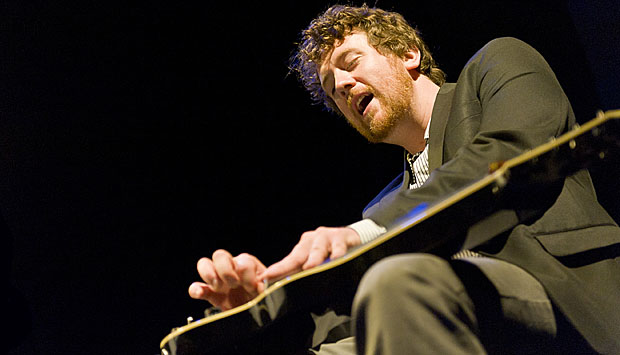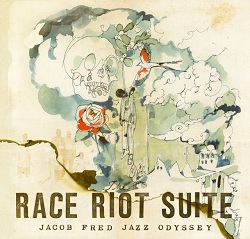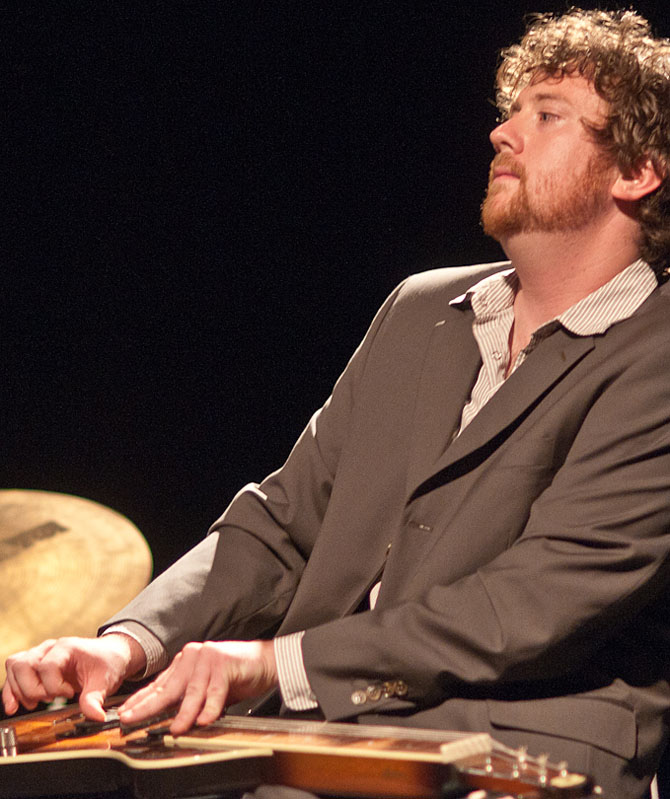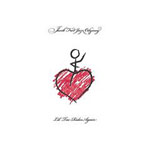Home » Jazz Articles » Interview » Chris Combs: Jacob Fred's Tulsa Tale
Chris Combs: Jacob Fred's Tulsa Tale

JFJO retains much of what I love about jazz, and also much of what I love about big, loud, rock and roll. We remain true to the music and ourselves and I believe people can feel that and relate to it, regardless of genre preconceptions.
"It was something that people didn't like talking about. They still don't like talking about it," said the lap steel guitarist. "The race riot was ignored for so long that has become one of the strangest and darkest parts of our city's history."
Combs's vision of describing this work in great and impassioned musical detail has already come to fruition. On May 20th 2011, JFJO premiered the Race Riot Suite to a live audience at the Tulsa Performing Arts Center. The suite, which will be released on the band's Kinnara Records on August 30, 2011, seeks to bring the events into literal and impressionistic light in the best way the quartet can. The suite's conception was borne out of the guitarist's inquisition into Tulsa's past.
"At the time I was just reading a lot about the Tulsa race riot," says Combs. Some great books have been published about the riot and you can learn so much if you dig a little. Initially I had a group of small musical ideas that were inspired by different historic pieces of the race riot. Separately, JFJO had been planning on doing a larger ensemble album. Gradually the two ideas converged and I began demoing all of the material late at night in our rehearsal space, playing all the parts by recording and overdubbing."
 Before the inception of Race Riot, Jacob Fred Jazz Odyssey was embarking on a very different kind of big project: Ludwig, the band's re-imagining of Beethoven's third and sixth symphonies. The creation, described by pianist Brian Haas as "The Far East Suite meets the Flaming Lips," was typical of JFJO; the melding of many different styles is something the band excels in. However, the scope of the work and getting inside Beethoven's head was a watershed experience.
Before the inception of Race Riot, Jacob Fred Jazz Odyssey was embarking on a very different kind of big project: Ludwig, the band's re-imagining of Beethoven's third and sixth symphonies. The creation, described by pianist Brian Haas as "The Far East Suite meets the Flaming Lips," was typical of JFJO; the melding of many different styles is something the band excels in. However, the scope of the work and getting inside Beethoven's head was a watershed experience. "Ludwig was something the band was talking about for a long time," explains Combs. "We had the opportunity to work with the Bartlesville Symphony Orchestra and worked with a young composer named Noam Faingold. With the final product, I don't think any of us had really heard anything like that before. The challenge of performing two Beethoven Symphonies with a 50-piece orchestra and maintaining the energy of a churning and improvising jazz quartet was immense. It was particularly difficult on lap steel, but was also an exciting opportunity to reinterpret the instrument.
"It was a huge impact getting to know the inner workings of the theme and variation," Combs continues, "hearing everything that was going on. I learned so much from Brian [Hass], [bassist] Jeff Harshbarger, and [drummer] Josh [Raymer], who all have classical upbringings. Working on something of that size was definitely some of the inspiration for working on the suite, which I began working on during that process. I think you can really hear, or at least I can hear, a lot of Beethoven in it."
The task of making Beethoven relevant and contemporary may have seemed like a big undertaking, but Combs found his work to be closer to the present than we think. "The music is not that far removed from contemporary culture. The melodic and the harmonic content are so strong. If you were to throw a backbeat on it, it could sound like Radiohead. And in any case, the music is completely genius. So it doesn't take a lot of work to make it sound mind-blowing."
Combs's involvement with Jacob Fred is an example of ascended fandom. Like many Tulsa musicians, the guitarist saw Jacob Fred Jazz Odyssey as a staple of the Tulsa musical diet and, through its outreach, Combs was added to create the group's contemporary quartet format.
"They were actually one of my favorite bands growing up," recalls Combs. "I went to a lot of Jacob Fred shows and nearly all the people that I've played with had as well. A few years ago, Brian [Haas] and Reid [Mathis] were spending more time in Tulsa and playing with the younger generation. I initially met them at shows and began playing with them through local gigs and jazz jams."
 Combs, as a Tulsa native, had a lot to draw from and therefore had a lot to offer the band. "I grew up playing guitar. My mother's side of the family is from New Orleans and my father's side of the family hails from the hills of Missouri, so I grew up with a steady stream of old jazz and rural folk music, balanced out by all of the Led Zeppelin, Yes, and The Beatles my parents were listening to. Tulsa is a city of great guitar players and the scene here has influenced me heavily."
Combs, as a Tulsa native, had a lot to draw from and therefore had a lot to offer the band. "I grew up playing guitar. My mother's side of the family is from New Orleans and my father's side of the family hails from the hills of Missouri, so I grew up with a steady stream of old jazz and rural folk music, balanced out by all of the Led Zeppelin, Yes, and The Beatles my parents were listening to. Tulsa is a city of great guitar players and the scene here has influenced me heavily." The lap pedal steel guitar, to put it lightly, is an uncommon instrument in the jazz world. Its signature slides and wails have given Jacob Fred's music as significant sonic coloring and have defined the last few records for JFJO. For Combs, it was as much a learning experience for him as it was a sonic affirmation for the rest of the band. "I was playing the first couple tours on electric guitar; at the time I joined in 2008, the band was touring for the record Lil Tae Rides Again. They actually knew at one point they wanted to include lap pedal steel because Reed had been playing it. He had been using it to recreate the electronic sonic tapestries of that album so the band expanded into a quartet to recreate that sound landscape. Reed showed me the first few things I learned on the instrument and slowly over the next few years on the road the lap steel took over and has become my primary instrument.
"I didn't really have any formal training. I've developed a style mostly autonomous from traditional steel playing. Steve Pryor, Tulsa-based guitar Godfather and longtime idol of JFJO, has been a huge influence on my steel playing. Learning it has allowed me to redefine myself as a musician."
After two records as a quartet, Race Riot Suite has allowed the band to momentarily reclaim its status as a large small group, the first time since the original octet format. Combs enlisted the help of a diverse and formidable cast of horn players—a mix of old friends and nationally established players. "The horn section is comprised of some of our biggest heroes and influences," Combs enthuses. "Steven Bernstein on trumpet and slide trumpet, Peter Apfelbaum on bari and tenor sax, Jeff Coffin on tenor, Mark Southerland, who's kind of the godfather of the Kansas city avant-garde, on tenor and homemade horns and Matt Leland, one of the found members of JFJO, on trombone. It was five really strong personalities. It was so inspiring to be in the same room with all of these people, let alone get to play with them; they are some of the best horn players and best people on the planet."
Enlisting the help of such a diverse cast seems only natural given the artistic and prosaic size of the album. Sonically, Combs drew from a huge tapestry of influences, everything from jazz's classic composers (Charles Mingus and Duke Ellington) and manic downtown ensembles (Skerik and Steven Bernstein's MTO) to artisan hip-hop (J-Dilla and Mad-Lib) and boldly adventurous melody-meets-noise rock technicians (Lightning Bolt and Sonic Youth).
 The actual musical styles in the suite ring very clearly of older jazz and pre-jazz styles like ragtime and second-line style stomps. "Some of the music is a very deliberate time travel to the music of the time," explains Combs. "In the '20s, there was a lot jazz from the territory bands of the time."
The actual musical styles in the suite ring very clearly of older jazz and pre-jazz styles like ragtime and second-line style stomps. "Some of the music is a very deliberate time travel to the music of the time," explains Combs. "In the '20s, there was a lot jazz from the territory bands of the time." The album traces the race riot in a linear fashion as well as an impressionistic one. Dotted with four short musical "prayers" throughout, each track represents a different moment and portrait of life in Tulsa before, during and after the riot. Though each track stands as an example of Combs's creativity in and of itself, there is an intricate and through-composed story arc woven throughout the album.
"'Black Wall Street' is the boomtown era Greenwood," said Combs, describing where the story begins, "which, at the time, was the most affluent black neighborhood and business district in the United States. 'The Burning' refers to both the riot itself and a great book on the riot by author Tim Madigan. 'Mt Zion' is the Baptist church that remained an icon in the Greenwood neighborhood."
The album continues to move into the aftermath of the riot. Combs explains, "'Lost in the Battle of Greenwood' is the funeral dirge for those lost in the riot. It also reflects the infinite resilience of Greenwood. 'Grandfather's Gun' is a piece about an infamous picture of a young white boy during the riot with two guns. His expression seems to be a mix of pride and sadness. This is his walk home. 'Cover Up' refers to a deliberate cover-up following the riot perpetrated by Tulsa's civic leaders who many, at the time, were members of the Ku Klux Klan. There are articles from local papers that allegedly called publicly for the attempted lynching that started the riot that have been crudely cut and removed from local archives. There wasn't a government-sanctioned search for fact until the National Parks Department Reconnaissance Survey that was conducted in 2001."

Before the final "prayer" is played, the penultimate track, "Eye of the Dove," brings the story to the present. "It brings us to modern times," said Combs. "This is our generation and the new and different challenges we face as humans striving to create and recreate America. I feel like we have a lot of work to do in this generation, a lot of healing."
For Combs, he is not alone in creating a work of this scope, especially not in the company of some of his favorite musicians. "The Suite is highly influenced by bands like the Flaming Lips and Radiohead who both tend to operate in a larger scope. I've always been attracted to that kind of stuff, albums by bands like Pink Floyd, Flaming Lips, albums like[John Coltrane's] A Love Supreme (Impulse!, 1965), etc. Fans of those bands have come to expect genuine and unique music that is intellectually and emotionally gratifying. I see a lot of parallels between our musics."
And within this logic lies the key to Jacob Fred's success—the pursuance of diversity. The band mentions Ornette Coleman and Bob Wills in the same breath and praises both Tom Waits and John Coltrane without batting an eyelid. For Combs and the rest of the band, diversity is not an active pursuit as much as it is a personal reflection. "In a lot of ways, musical diversity is the most natural thing for us to do. The easiest way to look at it is that's what our record collections look like. Our iPods are full of music from throughout the spectrum of taste and time That's just how our generation hears music."
It's not just the band's inner machinations that represent its diversity. JFJO's activity as a working ensemble has placed them all over the world, within the full spectrum of possibilities. "One of the first 'jazz' bands I really got into as a teenager was Medeski Martin & Wood," says Combs. "I quickly realized they were part of a rich lineage of musical revolutionaries dating back to turn of the century America. I think people can connect some of the same dots with JFJO. We occupy a diverse identity that allows us to play to a wide variety of audiences. This summer we played Montreal Jazz Festival and High Sierra Music Festival in the same weekend. To me, JFJO retains much of what I love about jazz, and also much of what I love about big, loud, rock and roll. We remain true to the music and ourselves and I believe people can feel that and relate to it, regardless of genre preconceptions.
 However, it needs to be mentioned that, for however cosmopolitan and worldly JFJO presents itself, Combs and the rest of the band stay very true to their Okie roots. Like The Flaming Lips' Wayne Coyne, Combs and the rest of the band still reside in the Midwest and their roots only grow stronger. "We love living in Tulsa," Combs enthuses. "The city has shaped us as people and the music scene has shaped us as musicians. Tulsa is undergoing a fantastic renaissance right now and there is a beautiful scene of people redefining what it means to exist in the Midwest. There is a lot to be learned, both from the treacherous and evil actions of some and the benevolence and resilience of others. Our bassist, Jeff Harshbarger, lives in Kansas City, MO where there is a powerful music art scene that embraces the traditional as well as the avant-garde. The KCMO community has made a huge aesthetic impact on JFJO.
However, it needs to be mentioned that, for however cosmopolitan and worldly JFJO presents itself, Combs and the rest of the band stay very true to their Okie roots. Like The Flaming Lips' Wayne Coyne, Combs and the rest of the band still reside in the Midwest and their roots only grow stronger. "We love living in Tulsa," Combs enthuses. "The city has shaped us as people and the music scene has shaped us as musicians. Tulsa is undergoing a fantastic renaissance right now and there is a beautiful scene of people redefining what it means to exist in the Midwest. There is a lot to be learned, both from the treacherous and evil actions of some and the benevolence and resilience of others. Our bassist, Jeff Harshbarger, lives in Kansas City, MO where there is a powerful music art scene that embraces the traditional as well as the avant-garde. The KCMO community has made a huge aesthetic impact on JFJO. "I've done a lot of living here," Combs states simply. And so long as the open plains and red dirt of the Midwest continue to inspire such creativity, JFJO's fans should only hope that the group does even more living there.
Selected Discography
Jacob Fred Jazz Odyssey, Race Riot Suite (Kinnara, 2011)
Jacob Fred Jazz Odyssey, Stay Gold (Kinnara, 2010)
Jacob Fred Jazz Odyssey, One Day in Brooklyn (Kinnara, 2009)
Jacob Fred Jazz Odyssey, Lil' Tae Rides Again (Hyena, 2008)
Jacob Fred Jazz Odyssey, The Sameness of Difference (Hyena, 2005)
Jacob Fred Jazz Odyssey, Walking With Giants (Hyena, 2004)
Jacob Fred Jazz Odyssey, Slow Breath, Silent Mind (Kufala, 2004)
Jacob Fred Jazz Odyssey, All is One: Live in New York City (Knitting Factory, 2002)
Photo Credits
Page 1: Jeremy Charles
Page 2: Dave Kaufman
Page 3: Jeremy Charles, courtesy of Jacob Fred Jazz Odyssey
< Previous
Flood Tide
Comments
Tags
Chris Combs
Interview
Daniel Lehner
United States
Jacob Fred Jazz Odyssey
Brian Haas
Jeff [Harshbarger]
Led Zeppelin
Yes
The Beatles
Steven Bernstein
Peter Apfelbaum
Jeff Coffin
Charles Mingus
duke ellington
Skerik's Syncopated Taint Septet
John Coltrane
Ornette Coleman
Tom Waits
Medeski, Martin & Wood
For the Love of Jazz
 All About Jazz has been a pillar of jazz since 1995, championing it as an art form and, more importantly, supporting the musicians who create it. Our enduring commitment has made "AAJ" one of the most culturally important websites of its kind, read by hundreds of thousands of fans, musicians and industry figures every month.
All About Jazz has been a pillar of jazz since 1995, championing it as an art form and, more importantly, supporting the musicians who create it. Our enduring commitment has made "AAJ" one of the most culturally important websites of its kind, read by hundreds of thousands of fans, musicians and industry figures every month.





















